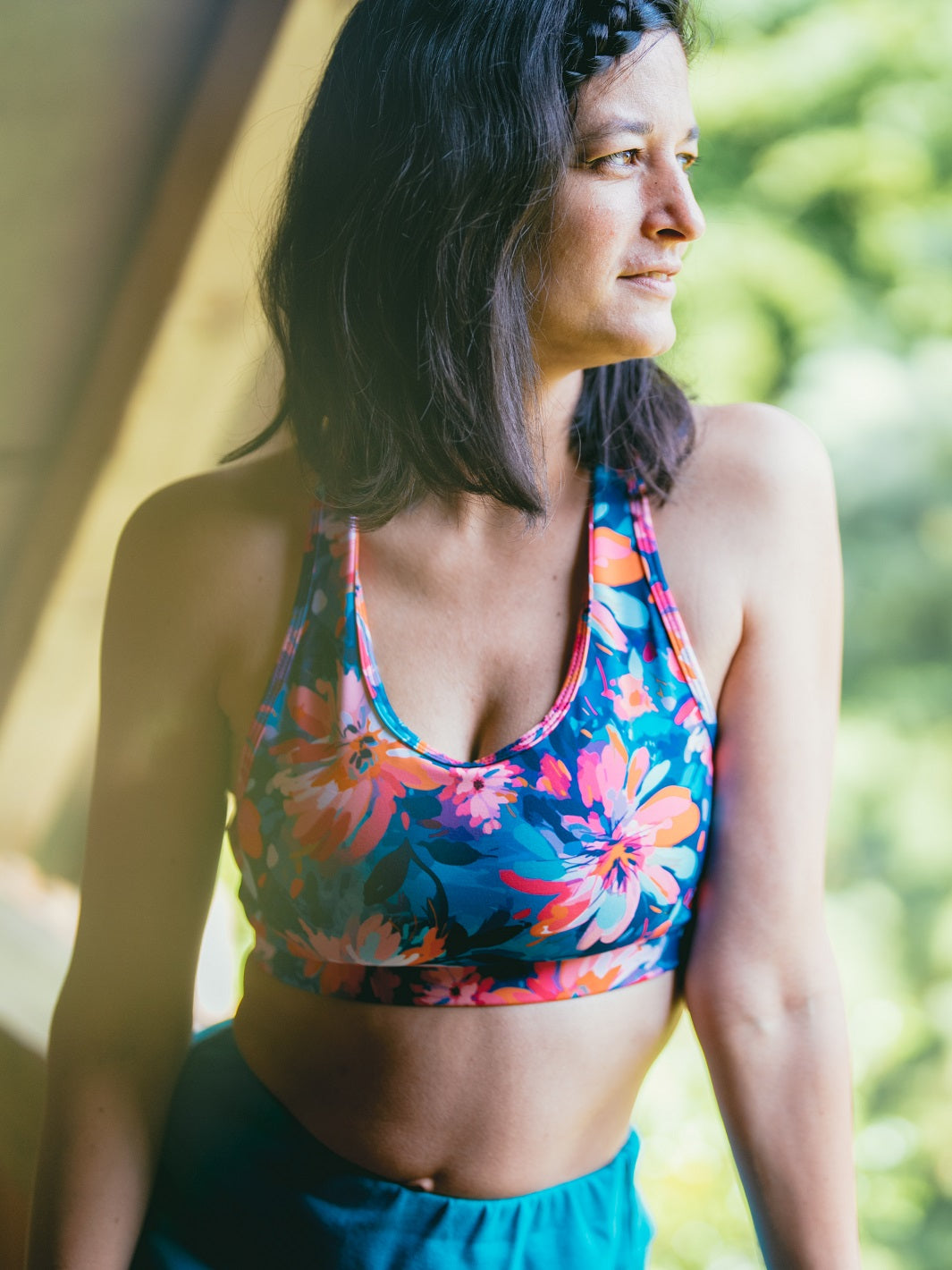Hello Yoginis!
Today we have a new post to talk about labels in fashion.
If you have landed here, it is probably because you are interested in eco-responsible fashion and want to refine your knowledge in this area to become an informed buyer.
There is a whole range of labels in the fashion world, which we will review in a moment, but one thing before we begin:
Regardless of the labels on a piece of clothing, you will always have a more positive impact on the environment by buying fewer clothes rather than a bunch of organic clothes.
And by washing clothes less often, which, whatever their composition, end up releasing microfibers into the washing water.
Also note that not all brands necessarily have the means to pay for certification by a label.
If you find clothing made locally in an eco-responsible material, that's already great!
Remember to carefully read the descriptions of the products you buy or the “about” sections because the labels are not necessarily printed on the clothing labels (this is not an obligation and it takes up a lot of space).
So what are labels for?
The labels guarantee and prove the ecological and social efforts of clothing brands and factories through external organizations.
It is precisely the certification by third parties carrying out regular audits which gives all their credibility to the different labels.
As for brands inventing their own labels, it's pure greenwashing.
Thank you and goodbye.
The labels validate certain specificities of eco-responsible fashion such as:
- The quality of raw materials
- The manufacturing process
- The absence of toxic and harmful substances to health
- Labor conditions
- Workers' compensation
There are many and it is sometimes difficult to navigate.
At Géopélie, all our clothes are made from Oekotex Standard 100, GRS and REACH certified fabrics. To find out more about our approach, you can consult this detailed article or look at this pretty infographic.
Let's decipher 11 of the most common textile labels and understand what they certify... or not.
1. Oekotex Standard 100
Certification by the Oekotex Standard 100 label guarantees the absence of substances dangerous to the health and skin of the consumer (heavy metals, pesticides, phthalates, benzene, allergenic dyes, etc.). Yarns, fabrics or finished products can be certified.
To find out more: https://www.oeko-tex.com/en/our-standards/oeko-tex-standard-100

2. Oekotex Made in Green
In addition to ensuring the non-toxicity of fabrics, this label takes into account manufacturing methods which must be eco-responsible (waste management, water saving, reduction of carbon emissions, protection of natural resources). Social responsibility is also taken into account (working conditions, prohibition of forced labor or child labor, fair remuneration) and the traceability and transparency of the production chain.
To find out more: https://www.oeko-tex.com/en/our-standards/oeko-tex-made-in-green

3. GOTS (Global Organic Textile Standard)
This is the label for organic textile fibers, available in two standards:
- To obtain the GOTS “organic” label, textile products must include at least 95% certified organic fibers.
- When the label mentions “composed of organic fibers”, the product contains at least 70% certified organic fibers.
The label has environmental requirements and ensures the absence of toxic chemical substances (heavy metals, solvates, nanoparticles, chlorine bleaches, phthalates, PVC) and GMOs. It takes into account waste management and wastewater treatment.
Concerning social requirements, only companies respecting the social criteria set by the ILO can be certified (prohibition of forced labor and child labor, decent working conditions, fair wages, etc.).
The last part revolves around health requirements. The label prohibits the use of substances toxic to health (azo dyes, aromatic solvents, phthalates, PVC). The label ensures a certain level of quality of the fabric and takes into consideration resistance to rubbing, perspiration, washing, shrinkage and color fastness.

4. GRS (Global Recycled Standard)
This label certifies that the materials used in the manufacture of textiles are indeed recycled. To be labeled “GRS”, a product must contain at least 50% recycled materials. The waste included in the composition of the final product is scrutinized and the percentage of post-consumer type waste (waste from households and businesses that cannot be reused in the manufacturing process) or pre-consumer type (waste produced during manufacturing and can be reused directly in the production line) must be indicated.
The label also has environmental requirements (control of energy and water consumption, production of CO2 emissions, waste management, wastewater treatment), social requirements (compliance with social minimum requirements, prohibition of forced and child labor, freedom of association, safety and health of workers, well-defined wages and employment contracts) and health requirements (exclusion of substances classified as dangerous for the environment and human health by REACH legislation).

5. French Origin Guaranteed
To be able to affix this transversal label (it is not strictly reserved for textile products but can be applied to any type of product), a product must follow the following criteria: “the place where the product takes on its essential characteristics is located in France and at least 50% of the unit cost price is acquired in France. »
A way of protecting the consumer from “fake” made in France, where for example only the clothing label would be sewn in the territory and everything else done elsewhere.

6. France Terre Textile
Established by French textile manufacturers, this label is the most demanding for Made in France since it takes into account the entire production chain of textile products, from the manufacture of yarns to clothing.
The mission is clear: preserve French know-how and jobs. It brings together companies that share the same vision of “Made in France” and consider that all production operations are as important as each other. »
To be authorized to use this label, a company must provide proof that a minimum of 75% of the manufacturing stages are carried out on French territory (all subcontractors must also be labeled France Terre Textile) and that it has a responsible approach (sustainability of know-how, environment, sustainable development). An audit is carried out every 3 years.
The France terre textile label has been extended to the regions, in order to highlight local know-how. Thus, we find 6 territories with French textile tradition: Vosges Terre Textile, Alsace Terre Textile, Nord Terre Textile, Auvergne Rhône Alpes Terre Textile, Troyes Champagne Terre Textile.
Currently, 150 companies have the France Terre Textile label.
To find out more: https://franceterretextile.fr/

7.REACH
REACH is a European regulation aimed at securing the manufacture and use of chemical substances in European industry.
This involves identifying, evaluating and controlling chemical substances manufactured, imported and placed on the European market.
As of May 31, 2018, more than 20,000 chemical substances are already known and their potential risks established; Europe thus has the legal and technical means to guarantee a high level of protection for all against the risks linked to chemical substances.
What does the acronym REACH mean?
- Registration of all substances manufactured or imported at more than 1 tonne per year;
- Evaluation of test proposals, registration files and substances;
- Authorization, for substances of very high concern;
- Restrictions, to manage risks linked to other chemical substances.
To comply with the REACH regulation, companies must register all chemical substances manufactured or imported into the EU (if they represent a quantity greater than 1 tonne per year).
The authorization procedure requires supervised use of the chemical substances of greatest concern, likely to cause serious irreversible effects on health or the environment. The objective is to achieve the substitution of the most dangerous substances with alternative substances or technologies that are safer for human health and the environment.
The restrictions limit or prohibit the manufacture, placing on the market or use of certain substances which constitute an unacceptable risk to human health and the environment.
To find out more: https://www.ecologie.gouv.fr/reglementation-reach

8. PETA
The acronym PETA stands for People for the Ethical Treatment of Animal. It is a non-profit association whose mission is to protect the rights and dignity of animals.
When a fabric or garment is PETA certified, it means that it does not contain any animal material (fur, leather, silk, down or wool).
PETA certification is declarative. Companies wishing to be certified by PETA must complete a questionnaire and sign a “statement of assurance” attesting that the products do not contain any animal materials. Certain products of a brand may be labeled alongside other, non-labelled products.

9. Fair Wear Foundation
The Fair Wear Foundation certification ensures that people involved in the manufacture of clothing have decent working conditions. It is a multi-stakeholder organization that works to improve working conditions in the textile industry, infamous for their mediocrity in some countries. The evaluation of these conditions is made through the 8 pillars defined by the Fair Wear Foundation, inspired by the conventions of the World Labor Organization.

10.RWS
The Responsible Wool label is a standard that assures consumers of the well-being of sheep and respect for the land on which they graze. It is also a guarantee of quality since the standard governs the processing of wool into fiber.
A product can be certified as soon as it contains 5% RWS wool. But all the wool components of the product must be RWS certified for the labeling to take place.
Animal welfare is defined in particular by 5 animal freedoms which must be respected by the breeder: the absence of hunger/thirst, the absence of discomfort, the absence of pain, the guarantee of sufficient space and mental well-being.
Land must not be subject to deforestation or be degraded.

11. Masters of Linen
The European Masters of Linen® certification regulates the stages of linen production and processing according to strict standards, in particular that they must take place in Europe.
As flax needs a humid and oceanic climate, a large part of the cultivation is located in Caen and Amsterdam. Growing European flax is possible!
The label guarantees that the flax comes from farming without GMOs, without irrigation and zero waste. It ensures that the working conditions required by the International Labor Office are respected.







Leave a comment